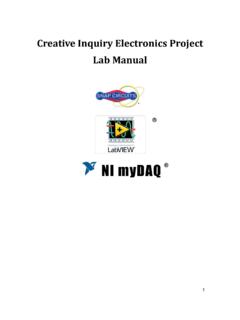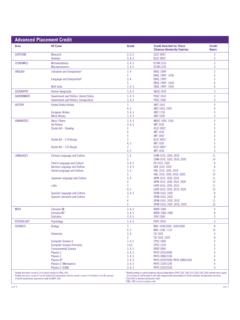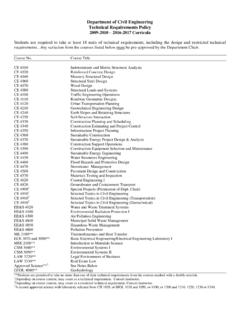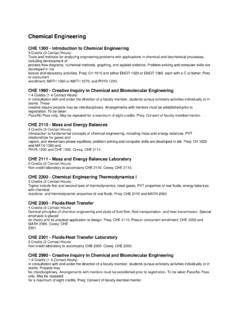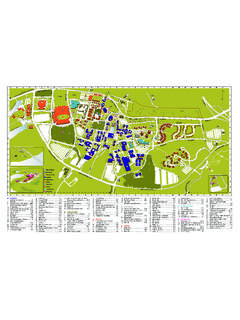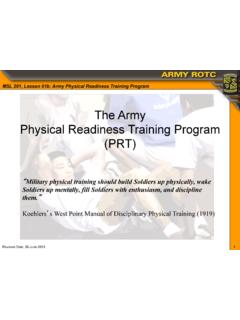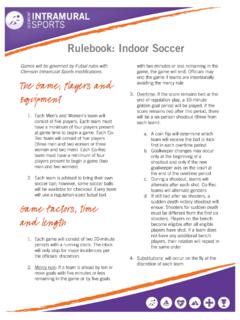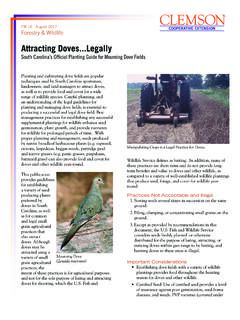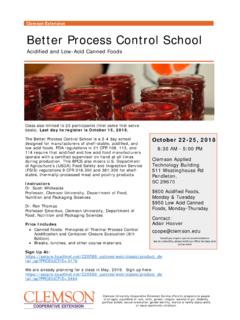Transcription of 1 Test Blueprint Guide - Clemson University
1 1 Test Blueprint Guide Creating a test Blueprint is great way to help you construct effective exams for your course. You can use test blueprints when creating new exams, evaluating existing exams, and creating multiple versions of exams with consistent difficulty. There are several approaches to creating test blueprints, but all share a focus on evaluating the alignment between learning objectives and assessments by comparing test question content and format with course objectives. CREATING NEW TESTS EVALUATING EXISTING TESTS MAKING MULTIPLE TEST VERSIONS Test blueprints are a simple tool to help faculty members be reflective and intentional when creating exams. Most test Blueprint approaches employ a simple matrix to ensure test questions reflect the course s learning objectives, incorporate varying levels of cognitive difficulty, and relative weight of course content.
2 This handout includes a broad overview and links to three resources for test Blueprint approaches. We also encourage faculty to utilize the Learning-Focused Test Guide for assessing the overall construction, alignment, and deployment of tests, to check for transparent, inclusive practices in incorporating tests into a course. We also suggest that faculty follow the General Test Construction Open Canvas Course for a guided walk through creating a test Blueprint and explore for the resource section below for additional examples of assessing affective learning objectives or exams within medical fields. The following is a general example of what a test Blueprint matrix could look like for evaluating an existing exam or quiz in an introductory physics course. The learning objectives for a sample course are listed in the first column, followed by different levels of cognitive processes across the top row, according to Bloom s Taxonomy (see for a description).
3 The number of test questions that address the category of each learning objective are then noted in each column. Learning Objectives for a Course or Unit Remember Understand Apply Analyze Evaluate Create Total 1. Define Newton s Laws of Motion 3 3 2. Draw a free body diagram of a soccer ball being kicked 2 2 1 1 5 3. Graph the horizontal and vertical velocity components of a projectile given the initial velocity and angle 1 1 2 4. Calculate the velocity components of a projectile at the maximum height 1 1 2 Total 7 2 2 0 0 1 12 Specifically, for each learning objective, the instructor notes the number of questions that reflect that objective and categorizes the type of cognitive process students engaged in while answering the question, in order to demonstrate their knowledge and understanding.
4 In the example matrix above, you can see that this test had 12 total questions. Three test questions were included requiring student to demonstrate knowledge of the definition of Newton s Laws of Motion, 2 and all three of these required students to engage the cognitive process of remembering. Reading across rows you can track how many test questions reflected each learning objective and reading down columns you can see how many questions fall into a particular cognitive process category. Then, you can decide if the test met your goals for that unit and for the course overall. Resources 1) The Learning-Focused Test Guide This Guide is uniquely designed to help faculty focus on their tests and examine how tests are introduced to students, how students are supported in their work, and how the work is assessed.
5 It is based on TILT: Transparency in Learning and Teaching. 2) General Test Construction Canvas Course Created by the Center for Instructional and Institutional Effectiveness, Weber State University . This freely accessible Canvas course leads the learner though three stages of test construction: planning, developing, and implementing tests. It offers faculty of all disciplines an overview helpful to novice and established instructors alike. This course includes a module on developing learning objectives, using Bloom s Taxonomy breaking down cognitive processes, and creating a test Blueprint matrix that you can use to help you develop your own matrix. This resource is recommended as a starting point if you are new to learning taxonomies such as Bloom s, crafting student learning outcomes, and aligning test questions with your learning outcomes.
6 An example page from the course Guide is below: Figure 1: This example page demonstrates a Test Blueprint matrix evaluating the cognitive domain of learning (reflects Bloom s Taxonomy) for a test in an introductory economics course. 3 3) Creating Test Questions from Student Learning Objectives in Individual Lesson Plans Created by Kevin Moberg, Department of Language & Literature and Teacher Education, Dickenson State University . This Test Blueprint approach builds test questions from lesson plans. The user starts by listing the learning objectives in the lesson plan and then designs questions or performance tasks to reflect each objective. Finally, the user evaluates the levels of learning in three possible domains: cognitive, affective, and psychomotor. The Cognitive Domain reflects the categories of Bloom s Taxonomy as discussed above.
7 This model also includes examination of affective and psychomotor skills . The Affective Domain reflects feelings and emotions. Learning in this domain is reflected by behaviors that indicate things such as interest, awareness, values, and attitudes. These kinds of learning are important in all classrooms and may be demonstrated in activities such as debate, teamwork , ethical case studies, and others. The Psychomotor Domain reflects physical functions, reflex actions, and interpretive movement objectives. These objectives reflect movement done to encode or demonstrate concepts; not simply physical acts done in support of cognitive learning. For example, looking through a microscope to describe cell division is not considered psychomotor as the physical act is only done to support the cognitive goal of understanding cellular division, whereas tuning instruments, performing dance movements, or dismantling/reassembling electronic components in proper order would be.
8 For more detail on these two domains and their associated taxonomies see Figure 2: The example page illustrates a Test Blueprint evaluating test questions in the affective domain. 4) Blueprints in Medical Education Fields Created by National Board of Medical Examiners. While this particular method is being used for courses in medical fields, it can be used in any discipline. The method breaks down key components of test blueprints in medical fields including: the purpose of the test, content framework, testing time, content weighing, and question formats. This method also provides guidance on (a) selecting items from a test question bank that align with objectives; (b) creating multiple versions of a test with 4 consistent difficulty; (c) ensuring the number of questions reflects focus on the topic; and (d) using blueprints as a Guide for students to demonstrate approaches to organizing content and relative value topics.
9 An example form that addresses content weighing in a physiology course is below: Figure 3: This example shows how you can shape the test to reflect the time dedicated to and relative weight of topics. While some topics have two days of lecture and require five questions, others have two days of lecture and require eight questions where topics This test Blueprint overview was created by S. Stefl, OTEI, 2019
